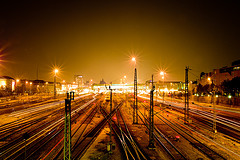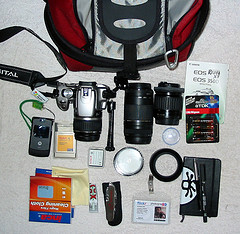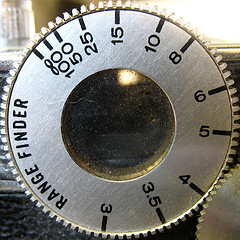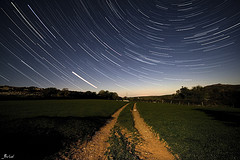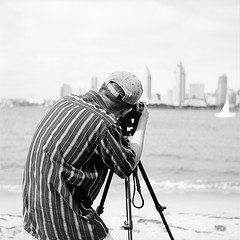 Victory in sports is about practice and performance - the best athletes prepare better than anyone else, training their bodies and minds to perform when winning and losing matter most.
Victory in sports is about practice and performance - the best athletes prepare better than anyone else, training their bodies and minds to perform when winning and losing matter most.
It's no different with sports photography. Those one-of-a-kind photos you see don't happen by accident, or just because the photographer was in "the right place, at the right time."
If you're serious about sports photography, then you need to do more than show up a sporting event with a camera. You might luck into a nice photo people will compliment you on, but if you take these tips to heart, you can rest assured you'll take great photo after great photo.
Know your sport.
I mean that literally. If you are going to photograph a sporting event, you have to understand the strategy well enough that you consider it your sport. That doesn't mean you have to play it or even know all the rules, but you must know what the point of the game is, as well as what is considered excellent performance. For example, in ice hockey, a player on the offense who is near the goal will sometimes pass the puck away from the goal and into what is seemingly empty space. To someone unfamiliar with the sport, it looks as if that's a mistake. But in reality the player is passing to empty space knowing that his teammate is going to time his skate to meet the pass, and take a shot on goal. It all happens in the blink of an eye, but if you have your camera trained on the momentarily "empty" space, you have a good chance of catching the instant the player strikes the puck with his stick. Or you could focus on the goalie knowing that a shot is coming.
For example, in ice hockey, a player on the offense who is near the goal will sometimes pass the puck away from the goal and into what is seemingly empty space. To someone unfamiliar with the sport, it looks as if that's a mistake. But in reality the player is passing to empty space knowing that his teammate is going to time his skate to meet the pass, and take a shot on goal. It all happens in the blink of an eye, but if you have your camera trained on the momentarily "empty" space, you have a good chance of catching the instant the player strikes the puck with his stick. Or you could focus on the goalie knowing that a shot is coming.
Focus on the players that will give you the best photo.
A lot goes on during a game. There are a lot of great pictures that you'll probably miss. Focus on getting the best shot you can in any particular moment, and don't worry about the ones you missed. During a tennis match, take time to focus on one player's serve. Then, switch your attention to the other players return. Very quickly, you will find yourself becoming a part of the rhythm of the game. And once you reach that point, you'll see opportunities as appear.
While photographing a high school basketball game, I focused on the best player on each team. Now, I knew that other players would make great shots, but I also knew that teammates would look to both of these players. When the ball came to them, I took pictures. When they passed the ball, I took pictures. I avoided getting too distracted by other action. Both of these players went on to be stars in college, one of them played in the NBA, and I got some great shots that night. Be prepared.
Be prepared.
When those opportunities for the "money" shot do appear, don't get caught unprepared. I've known photographers who've forgotten to take their lens caps off and missed something great. Or, they may not have changed their ISO setting from the last time they used their camera. If you want to manually control the settings, then be sure to take your camera off automatic so the flash doesn't pop up when you least want it to.
Remember, you're not just there to watch the game. You're there to take a great photograph or two. Keep your camera in your hands, with a clean lens, the right lenses close at hand, and make sure your battery is fully charged.
Also, pay attention to weather conditions. Just because it's raining doesn't mean you can't take great photos. In fact, the drama may be increased by the presence of water on the field. If it's going to be a bright sunny day and your daughter's soccer game is at 7:30 on a Saturday morning, then you'll want to make sure you account for both the glare of the sun and the glint of dew that's sure to be on the fields.
Know your equipment.
Of course, in order to be prepared, you need to know what your camera can and can't do. The last place you want to become familiar with your equipment is at the sporting event you paid $100 to get into, or at your daughter's TaeKwonDo National Championship competition. If you have relatives or friends who play on sports teams, ask if you can take pictures of their events. It will be good practice for you, and they will love to see the pictures you take. If you don't already have a SLR camera with a telephoto lens, I recommend you get one. A point and shoot camera is good for portrait shots before and after the game, not fast moving action. And don't be too intimidated by SLRs or telephoto lenses. They behave much the same way as point and shoots do when you set them on fully automatic. But you gain a lot of flexibility that point and shoot cameras simply don't have.
If you don't already have a SLR camera with a telephoto lens, I recommend you get one. A point and shoot camera is good for portrait shots before and after the game, not fast moving action. And don't be too intimidated by SLRs or telephoto lenses. They behave much the same way as point and shoots do when you set them on fully automatic. But you gain a lot of flexibility that point and shoot cameras simply don't have.
Location, location, location and timing, timing, timing.
These are the two most important things to keep in mind in sports photography, and they cannot be separated. You have to be in the right place at the right time in order to get a truly great sports photograph. And it doesn't have anything to do with luck. If your son's high school football team is marching down the field for a touchdown, then don't get so caught up in the game that you forget to rush to the back of the end zone. From there, you can get the perfect shot of a receiver catching a touchdown pass or a fullback barreling into the end zone.
Don't be shy about getting into position, either. I'm not recommending you sneak onto the sidelines during the Super Bowl and risk arrest. But at many events, if you ask politely and explain what you're doing, officials will let you on the sidelines. Also, you can check ahead to see if you can get a sideline pass. They aren't reserved solely for the media. It's good to check well before the event, but if you can't, try asking at the ticket office when you arrive. After all, the worst they can do is say no! Sports stir the soul - for millions of fans, watching their favorite teams fight for victory, even if they end up in defeat, inspires them in their day-to-day lives. Your photos can have a similar impact.
Sports stir the soul - for millions of fans, watching their favorite teams fight for victory, even if they end up in defeat, inspires them in their day-to-day lives. Your photos can have a similar impact.
Imagine a parent's delight when you present them with a picture of their child scoring a touchdown or goal ... imagine your lasting memories when you take a picture of your own child's moments of glory. It will affirm their dedication - and yours - and inspire you both for many years to come.
Matt Smolsky develops marketing programs and has written articles for a variety of clients, including Hoorray, a photo sharing website that offers a free online photo album to new members and is the easiest place to create a digital photo album, calendar, and other photo keepsakes.
PictureCorrect Comment: The Canon EF 400mm f/2.8 L IS USM Lens is probably the best track/field sports lens available. It is a super telephoto L-series lens with an Image Stabilizer that works great for all different kinds of sports situations.


